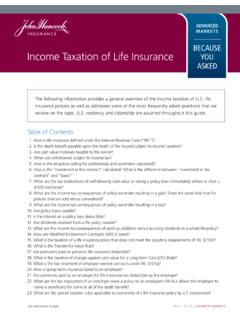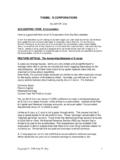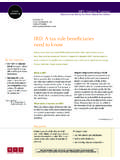Transcription of THE IMPACT OF THE COMMUNICATIONS …
1 TAX AND COMMERCE@OECDTHE IMPACT OF THE COMMUNICATIONSREVOLUTION ON THE APPLICATION OF PLACE OF EFFECTIVE MANAGEMENT AS A TIE BREAKER RULEA DISCUSSION PAPER FROM THE TECHNICAL ADVISORY GROUP ON MONITORING THEAPPLICATION OF EXISTING TREATY NORMS FOR THE TAXATION OF BUSINESS PROFITSF ebruary 2001 DRAFT FOR PUBLIC COMMENTD eadline: 30 June 20012 TABLE OF CONTENTSI ntroduction ..3 Taxing principles and double taxation ..3 Resolving residence-residence do you determine a place of effective management in a traditional environment?..4 Guidance from Central Management & Control (CM&C) ..5 Guidance from place of management ..6 Summary of key factors in determining a place of effective in a modern, technologically advanced of effective management in multi-jurisdictions ..8 Mobility ..9 Anomalies ..9 Options to resolve the of effective management in multi-jurisdictions ..10A)Replace the place of effective management concept.
2 10i) Place of incorporation or, in the case of an unincorporated association, place where corporate law applies to the enterprise ..10ii) Place where the directors/shareholders ) Where the economic nexus is strongest ..11B)Refine the place of effective management test ..12 Addressing mobility ..13C)Establish a hierarchy of tests, as in the individual ..13D)A combination of options B and dual resident companies the benefits under the Convention ..14 Where to from purpose of this paper is to identify possible limitations we are likely to face with theapplication of the place of effective management tie breaker rule in the current and futureenvironment of electronic commerce and technology and to identify possible paper is broadly divided into four parts. The first part of the paper provides a briefbackground to taxing principles, double taxation and the role of the residence tie-breaker.
3 The secondpart looks at the guidance that is available on how the place of effective management may bedetermined in a traditional environment. It attempts to draw together, from a number of differentsources, the list of key factors for determining a place of effective management . The third part of thepaper considers how these key factors may apply in a modern, technologically advanced , the paper will identify possible options to overcome the tie-breakers limitations. In doing so,some specific issues are identified for further consideration, and comments are sought on these optionsand principles and double are two main principles under which countries tax income - source and derived by a person may be taxed by a country because of a connection between thecountry and the generation of the income (source jurisdiction). For example, a business is carried on inthe country, real property is located in the country, or an employee works in that country.
4 Countriesassert source jurisdiction to tax income on the basis that the income is generated from economicactivity within the may also tax income (wherever derived) because the person earning the income isa resident of that country (residence jurisdiction). A country s justification for residence tax may beseen to rest on the need to finance its public goods and social infrastructure, and the nexus between theconsumption of such public goods and social infrastructure by persons who are residents having anover-all capacity to countries tax income on both a source and residence basis. That is, a resident person isusually taxed on income from both domestic and foreign sources, whilst non-residents are only taxedon domestic source instances of double taxation will arise as a result of residence-source jurisdictionalconflicts. However, double taxation can also arise from residence-residence conflicts where bothContracting States treat a person as a resident for tax purposes under their domestic law (with theresult that the person is fully liable to tax in both States).
5 Main focus of Double Tax Conventions is to avoid such double taxation which, if notaddressed, may impede cross border flows of trade, investment and residence-residence OECD Model Tax Convention deals with residence -residence conflicts throughtie-breaker rules in Article 4 which allocate residence of the dual resident person to one of those4 States, so that person is treated as a resident solely of that State for the purposes of the Convention. Inthe case of an individual, the tie-breaker rules look at various indicia of personal attachment to a Statewith a view to determining to which State it is felt to be natural that the right to tax devolves. the case of companies and other bodies of persons, a tie-breaker rule based on personalattachment is clearly not appropriate. The Commentary also rejects a tie-breaker based on purelyformal criteria such as registration.
6 In giving preference to the State where the entity is actuallymanaged 2, it would seem that the intention is to select a criterion which reflects where the mainmanagement decisions are 3 of Article 4 of the OECD Model Tax Convention states that a non-individual: ..shall be deemed to be a resident only of the State in which its placeof effective management is situated. [Highlight added]How do you determine a place of effective management in a traditional environment? meaning of the term place of effective management is not defined in Article 4 of theOECD Model Tax Convention. However, the following new paragraph 24 in the Commentary onArticle 4 which was included in the 2000 Update to the Model, offers some guidance on the meaningof this term. place of effective management is the place where keymanagement and commercial decisions that are necessary for theconduct of the enterprise s business are in substance made.
7 The placeof effective management will ordinarily be where the most seniorperson or group of persons (for example a board of directors) makesits decisions, the place where the actions to be taken by the enterpriseas a whole are determined; however, no definitive rule can be givenand all relevant facts and circumstances must be examined todetermine the place of effective management. An enterprise may havemore than one place of management, but it can have only one place ofeffective management at any one time. new paragraph reinforces the point that the determination of a place of effectivemanagement is a question of term place of effective management is also used in Article 8 (Shipping, InlandWaterways Transport and Air Transport) of the OECD Model Tax Convention as the key criterion fordetermining the allocation of taxing rights over income derived from the operation of ships or aircraftin international traffic.
8 The term is also used under Article 13(3), 15(3) and 22(3) for allocating taxingrights to capital gains or dependent personal services income from shipping, inland waterways and , the term place of effective management is not defined in any of the Articlesmentioned above. Nor is any further guidance given on its meaning. 10 of the Commentary on Article 4 of the Model Tax 22 of the Commentary on Article 4 of the Model Tax the absence of any specific definition of place of effective management , manycommentators have been influenced by concepts used in domestic tax law residence rules, such as central management and control 3 and place of management 4, when considering the meaning of theterm place of effective management .Guidance from Central Management & Control (CM&C) is one of the residence tests adopted in a number of different countries5 fornon-individuals.
9 For example, under Section 6(1) of Australia s Income Tax Assessment Act 1936, acompany is a resident of Australia if: It is incorporated in Australia; or It carries on business in Australia and is centrally managed and controlled in Australia;or It carries on business in Australia and its voting power is controlled by shareholdersresident in the factors which determine a place of CM&C may provide assistance indetermining a place of effective Australia, the expression centrally managed and controlled is not defined in thedomestic tax legislation. However, there are a number of court cases which provide some guidance onhow the place of CM&C is to be to a number of court decisions, while determining a place of CM&C is a questionof fact, it ordinarily coincides with the place where the directors of the company exercise their powerand authority (which will generally be where they meet).
10 6 A leading case establishing this is De BeersConsolidated Gold Mines (1906) AC 455. In that case a company registered in South Africa workeddiamond mines, had its Head Office and held its general meetings of shareholders all in South Directors held meetings both in South Africa and in the United Kingdom, but the Directors meetings held in the United Kingdom were found to be those where real control of the company wasexercised. Accordingly the company was found to be UK a number of Canadian cases,7 the courts, relying on the statement of the Lord Chancellorin the De Beers case, have found that the place of CM&C was where the company really keeps houseand does business . Some of the factors taken into account in determining this place include: 3. See Hamilton, R and Deutsch R, Guidebook to Australian Taxation, Legal Books Looseleaf Service,Paragraph [ ].














